 W
WAcrobat and Young Harlequin is a 1905 painting by Pablo Picasso. Painted toward the end of Picasso's Blue Period and the outset of his Rose Period, the work displays characteristics of both, with its melancholic subject and its blue and rose palette. Picasso created the painting while at the Le Bateau-Lavoir, his home and studio in Montmartre, Paris.
 W
WThe Actor (L'acteur) is an oil on canvas painting by Spanish painter Pablo Picasso, created in 1904.
 W
WAgostina Segatori Sitting in the Café du Tambourin was painted by Vincent van Gogh in 1887. Agostina Segatori owned the Café du Tambourin that Van Gogh knew intimately. It was a gathering spot for Parisian artists, a place where their work was exhibited. Van Gogh, unable to pay in cash for his meals, exchanged paintings for his fare. The paintings then adorned the restaurant. He held a special exhibit of his Japanese prints in the café as well. His connection with Agostina and the cafe came to a sad end when she went bankrupt and van Gogh's paintings were confiscated by creditors. This painting, however, demonstrates an artistic discovery that culminated in his unique, creative style not quite on the brink of being understood and revered.
 W
WAt the Moulin Rouge is an oil-on-canvas painting by French artist Henri de Toulouse-Lautrec. It was painted between 1892 and 1895. It is one of a number of works by Toulouse-Lautrec depicting the Moulin Rouge cabaret built in Paris in 1889; the others include At the Moulin Rouge, The Dance, and the poster Moulin Rouge: La Goulue. Included in the background is a self-portrait of the artist.
 W
WAt the Moulin Rouge, the Dance is an oil-on-canvas painted by French artist Henri de Toulouse-Lautrec. It was painted in 1890, and is the second of a number of graphic paintings by Toulouse-Lautrec depicting the Moulin Rouge cabaret built in Paris in 1889. It portrays two dancers dancing the can-can in the middle of the crowded dance hall. A recently discovered inscription by Toulouse-Lautrec on the back of the painting reads: "The instruction of the new ones by Valentine the Boneless." This means that the man to the left of the woman dancing, is Valentin le désossé, a well-known dancer at the Moulin Rouge, and he is teaching the newest addition to the cabaret. To the right, is a mysterious aristocratic woman in pink. The background also features many aristocratic people such as poet Edward Yeats, the club owner and even Toulouse-Lautrec's father. The work is currently displayed at the Philadelphia Museum of Art.
 W
WAu Lapin Agile is a 1905 painting by Pablo Picasso. The harlequin is a self-portrait of the artist. The woman represents his lover Germaine Pichot, formerly the obsession of Carlos Casagemas, a friend of Picasso who committed suicide in 1901 because of an unreturned love for Pichot. In 1907 Pichot appeared as one of the models in Picasso's Les Demoiselles d'Avignon.
 W
WBaigneuses, also called Bathers, is a Proto-Cubist painting, now lost or missing, created circa 1908 by the French artist and theorist Jean Metzinger. Possibly exhibited during the spring of 1908 at the Salon des Indépendants. This black-and-white image of Metzinger's painting, the only known photograph of the work, was reproduced in Gelett Burgess, "The Wild Men of Paris", Architectural Record, May 1910. The painting was also reproduced in The New York Times, 8 October 1911, in an article titled "The 'Cubists' Dominate Paris' Fall Salon", and subtitled, "Eccentric School of Painting Increases Its Vogue in the Current Art Exhibition - What Its Followers Attempt to Do".
 W
WBal du moulin de la Galette is an 1876 painting by French artist Pierre-Auguste Renoir. It is housed at the Musée d'Orsay in Paris and is one of Impressionism's most celebrated masterpieces. The painting depicts a typical Sunday afternoon at the original Moulin de la Galette in the district of Montmartre in Paris. In the late 19th century, working class Parisians would dress up and spend time there dancing, drinking, and eating galettes into the evening.
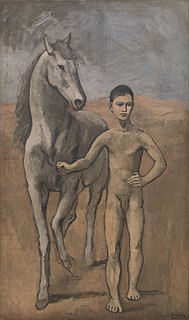 W
WJeune garçon au cheval is an early painting by Pablo Picasso. It is a work from Picasso's Rose Period, having been painted in 1905-06 in Paris.
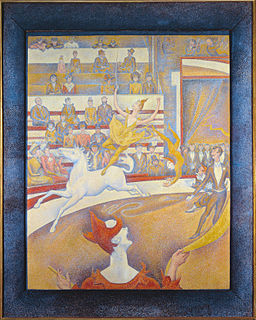 W
WThe Circus is an oil on canvas painting by Georges Seurat. It was his last painting, made in a Neo-Impressionist style in 1890-91, and remained unfinished at his death in March 1891. The painting is located at the Musée d'Orsay in Paris.
 W
WLes Demoiselles d'Avignon is a large oil painting created in 1907 by the Spanish artist Pablo Picasso. The work, part of the permanent collection of the Museum of Modern Art, portrays five nude female prostitutes in a brothel on Carrer d'Avinyó, a street in Barcelona. Each figure is depicted in a disconcerting confrontational manner and none is conventionally feminine. The women appear slightly menacing and are rendered with angular and disjointed body shapes. The figure on the left exhibits facial features and dress of Egyptian or southern Asian style. The two adjacent figures are shown in the Iberian style of Picasso's native Spain, while the two on the right are shown with African mask-like features. The ethnic primitivism evoked in these masks, according to Picasso, moved him to "liberate an utterly original artistic style of compelling, even savage force."
 W
WDeux Nus is an early Cubist painting by the French artist and theorist Jean Metzinger. The work was exhibited at the first Cubist manifestation, in Room 41 of the 1911 Salon des Indépendants, Paris. At this exhibition the Cubist movement was effectively launched before the general public by five artists: Metzinger, Gleizes, Le Fauconnier, Delaunay and Léger. This was the first exhibition during which artists, writers, critics and the public at large encountered and spoke about Cubism. The result of the group show is a succès de scandale.
 W
WFamille d'acrobates avec singe is a 1905 painting by Pablo Picasso. The work was made on cardboard using mixed media: gouache, watercolour, pastel and Indian ink. It measures 104 cm × 75 cm and is held by the Gothenburg Museum of Art. The work was painted at a key phase in Picasso's life, as he made the transition from an impoverished bohemian at the start of 1905 to a successful artist by the end of 1906.
 W
WFamily of Saltimbanques is a 1905 painting by Pablo Picasso. The work depicts six saltimbanques, a kind of itinerant circus performer, in a desolate landscape.
 W
WGarçon à la Pipe is a painting by Pablo Picasso. It was painted in 1905 when Picasso was 24 years old, during his Rose Period, soon after he settled in the Montmartre section of Paris, France. The oil on canvas painting depicts a Parisian boy holding a pipe in his left hand and wearing a garland or wreath of flowers.
 W
WLa Gommeuse [la ɡɔmøz] is a 1901 oil on canvas painting by the Spanish artist Pablo Picasso. It dates from his so-called Blue period and is noted for its caricature of Picasso's friend Pere Mañach painted on the reverse. It was offered for sale ex the William I. Koch collection at a Sotheby's, New York, auction on 5 November 2015. The painting realized $67.5 million at the sale, a record for a Blue period Picasso and placing the painting among the most expensive ever sold.
 W
WMiss La La at the Cirque Fernando is an oil on canvas painting by the French Impressionist artist Edgar Degas. Painted in 1879 and exhibited at the Fourth Impressionist Exhibition in Paris that same year, it is now in the collection of the National Gallery in London. It is Degas's only circus painting, and Miss La La is the only identifiable person of color in Degas's works. The special identity of Miss La La and the great skills Degas used in painting her performance in the circus made this piece of art important, widely appreciated but, at the same time, controversial.
 W
WThe Montmartre paintings are a group of works that Vincent van Gogh made in 1886 and 1887 of the Paris district of Montmartre while living there, at 54 Rue Lepic, with his brother Theo. Rather than capture urban settings in Paris, van Gogh preferred pastoral scenes, such as Montmartre and Asnières in the northwest suburbs. Of the two years in Paris, the work from 1886 often has the dark, somber tones of his early works from the Netherlands and Brussels. By the spring of 1887, van Gogh embraced use of color and light and created his own brushstroke techniques based upon Impressionism and Pointillism. The works in the series provide examples of his work during that period of time and the progression he made as an artist.
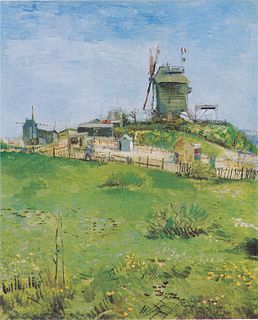 W
WLe Moulin de la Galette is the title of several paintings made by Vincent van Gogh in 1886 of a windmill, the Moulin de la Galette, which was near Van Gogh and his brother Theo's apartment in Montmartre. The owners of the windmill maximized the view on the butte overlooking Paris, creating a terrace for viewing and a dance hall for entertainment.
 W
WMoulin Rouge: La Goulue is a poster by French artist Henri de Toulouse-Lautrec. It is a colour lithograph from 1891, probably printed in about 3,000 copies, advertising the famous dancers La Goulue and "No-Bones" Valentin, and the new Paris dance hall Moulin Rouge. Although most examples were pasted as advertising posters and lost, surviving examples are in the collection of the Indianapolis Museum of Art and many other institutions.
 W
WNu à la cheminée, also referred to as Nu dans un intérieur, Femme nu, and Nu or Nude, is a painting by Jean Metzinger. The work was exhibited in Paris at the Salon d'Automne of 1910, and the Salon de la Section d'Or, Galerie La Boétie in Paris, October 1912. It was published in Du "Cubisme", written by Jean Metzinger and Albert Gleizes in 1912, and subsequently published in The Cubist Painters, Aesthetic Meditations by Guillaume Apollinaire, 1913. Nu à la cheminée was in the collection of G. Commerre at the time. The work has not been seen in public since, and its current location is unknown.
 W
WL'Oiseau bleu is a large oil painting created in 1912–1913 by the French artist and theorist Jean Metzinger (1883–1956); considered by Guillaume Apollinaire and André Salmon as a founder of Cubism, along with Georges Braque and Pablo Picasso. L'Oiseau bleu, one of Metzinger's most recognizable and frequently referenced works, was first exhibited in Paris at the Salon des Indépendants in the spring of 1913, several months after the publication of the first Cubist manifesto, Du "Cubisme", written by Jean Metzinger and Albert Gleizes (1912). It was subsequently exhibited at the 1913 Erster Deutscher Herbstsalon in Berlin.
 W
WPortrait of Père Tanguy, painted by Vincent van Gogh in 1887, is one of his three paintings of Julien Tanguy. The three works demonstrate a progression in van Gogh's artistic style after his arrival in Paris. The first is somber, and formed from a simple composition. The second introduces van Gogh's Japanese prints. The last and most advanced in style, skill and color integrates Japanese, Impressionist, and other influences on the Parisian artist community. This painting conveys a sense of serenity that van Gogh seeks for himself. This last painting of Tanguy is in the Musée Rodin, Paris.
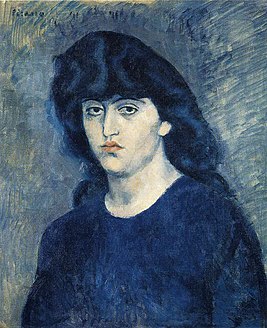 W
WPortrait of Suzanne Bloch is a painting executed by the Spanish artist Pablo Picasso in Paris in 1904, towards the end of his blue period. The subject, Suzanne Bloch, was a singer known for her Wagner interpretations, and the sister of the violinist Henri Bloch.
 W
WPortrait of Vincent van Gogh is an 1887 chalk pastel on cardboard by Henri de Toulouse-Lautrec. Toulouse-Lautrec had encountered Vincent van Gogh, eleven years his senior, when they were both taking lessons at the open studio of Fernand Cormon in Paris from 1886 to 1887. The painting is held by the Van Gogh Museum in Amsterdam, catalogued "d693V/1962".
 W
WStill life paintings by Vincent van Gogh (Paris) is the subject of many drawings, sketches and paintings by Vincent van Gogh in 1886 and 1887 after he moved to Montmartre in Paris from the Netherlands. While in Paris, Van Gogh transformed the subjects, color and techniques that he used in creating still life paintings.
 W
WThe Swing is an 1876 oil on canvas painting by the French artist Pierre-Auguste Renoir who was a leading exponent of the Impressionist style. The painting measures 92 x 73 centimetres and is in the Musée d’Orsay. Renoir executed the painting in what are now the Musée de Montmartre gardens. He had rented a cottage in the gardens so that he could be closer to the Moulin de la Galette where he was engaged in painting Bal du moulin de la Galette.
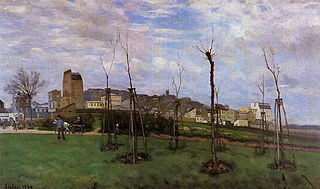 W
WView of Montmartre from Cité des Fleurs to Les Batignolles is a painting by Alfred Sisley, produced in spring 1869 and now in the Musée de Grenoble, France Inv. MG 1317). It was given to that museum in 1901 by the artist's friend and fellow painter Joseph-Auguste Rousselin, only two years after Sisley's death. It is one of the first Impressionist paintings to depict Montmartre, showing it as a still rural area.
 W
WView of Paris from Vincent's Room in the Rue Lepic is a painting by Dutch post-impressionist artist Vincent van Gogh.
 W
WVue de toits is an oil painting by French impressionist Gustave Caillebotte executed in the winter of 1878 and 1879. The canvas measures 81 by 65 centimetres. It was originally gifted by Caillebotte's brother in 1894 to the Musée du Luxembourg, then transferred to the Musée du Louvre in 1929. In 1947, it was moved to the Galerie nationale du Jeu de Paume, which held many impressionist works in France after World War II. In 1986, it was transferred again to the Musée d'Orsay in Paris, where it is currently displayed. The painting is one of the few Caillebotte works that have remained in public view since the artist's death in 1894.
 W
WThe Wall of Love is a love-themed wall of 40 square metres (430 sq ft) in the Jehan Rictus garden square in Montmartre, Paris, France. The wall was created in 2000 by calligraphist Fédéric Baron and mural artist Claire Kito and is composed of 612 tiles of enamelled lava, on which the phrase 'I love you' is featured 311 times in 250 languages. Each tile is 21 by 29.7 centimetres.
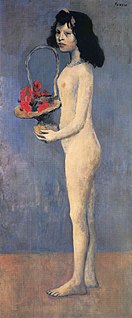 W
WYoung Girl with a Flower Basket is a 1905 painting by Pablo Picasso from his Rose period. It was painted at a key phase in Picasso's life, as he made the transition from an impoverished bohemian at the start of 1905 to a successful artist by the end of 1906.